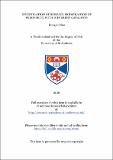Investigation of surface modification of perovskite with different catalysts
Abstract
The increasing energy requirements of mankind have stimulated the need to search for
renewable clean energy in order to protect the environment. Proton Exchange
Membrane Fuel Cells (PEMFC) are one of the most promising types of fuel cell among
the entire range of power generation devices. However, the high quantity of noble metal
catalysts used in PEMFCs hinders their commercialization due to the associated high
cost. Decreasing the amount of noble metal catalysts without sacrificing the
performance of the fuel cell is therefore desirable.
This thesis explores the possibility of modifying the perovskites with small quantities of
the most commonly used catalysts (Ni, Ru and Pd) on its surface, with the intention to
create a potentially cost-effective electrode material for PEMFC. The perovskites
employed in this thesis include two of the most commonly studied perovskite materials,
A-site deficient titanate based perovskites and LaCrO₃ based perovskites. The concept
of the modification method is to combine two of the most promising state of the art
methods, impregnation and exsolution, to improve the properties of the perovskite.
Instead of incorporating the catalyst in the whole lattice of the perovskite, the
impregnation method was used to dope the catalyst into the surface of the perovskite
only. The exsolution of the doped catalysts from the perovskite was then attempted. This
would theoretically produce nanoparticles with certain parts of its body anchored inside
the perovskite, thus avoiding the catalyst agglomeration problem which has been
reported for the normal impregnation method.
The A-site deficient titanate perovskite used to investigate surface doping modifications
is La₀.₄Sr₀.₄GaₓTi₁₋ₓO[sub](3-x/2) (LSGT). At first, a Ni catalyst was used to explore the
possibility and optimal experimental conditions for catalyst doping of the perovskite
from the surface and subsequent exsolution. The microstructure of the LSGT scaffold
was optimized for later experiments. The results from the Ni doping study were then
applied to the surface doping of Pd and Ru catalysts. This work demonstrates the
possibility of incorporating Ni, Ru and Pd catalysts into the surface of A-site deficient
titanate LSGT perovskite, using a pre-reduction treatment. The doped Ni and Pd
catalysts managed to exsolve to the surface of the perovskite as nanoparticles after reduction treatment. However, the Ru catalyst did not exsolve under the same
experimental conditions. It has been found that different catalysts require different
conditions to be able to dissolve into the perovskite for example, the heating atmosphere.
In addition, the mechanism of incorporating Pd into the A-site deficient titanate has
been studied, showing that the Pd is doped into the A-site deficient titanate in the form
of Pd²⁺ with square planar 4-fold coordination on the B-site.
The LaCrO₃ based perovskite employed for studying the incorporation of a catalyst into
the surface of the perovskite was La₀.₇₅Sr₀.₂₅Cr₀.₅Mn₀.₅O₃ (LSCM). The possibility of
doping ruthenium into the surface of LSCM perovskite with the aid of a ball milling
process has been explored by VT-XRD. It has been demonstrated that the Ru catalysts
are able to dissolve into the lattice of LSCM perovskite on oxidation and exsolve as
nanoparticles upon reduction. In addition, the addition of a Ru catalyst into the LSCM
has been shown to improve the reducibility of the perovskite. Then the possibility of
incorporating a Pd catalyst into the surface of LSCM perovskite was investigated. It was
found that the Pd was unable to be doped into the LSCM perovskite due to the fact that
the structure of LSCM was not rigid enough to accommodate the deficiencies
introduced by Pd.
Catalytic tests of RWGS reactions were carried out with a few selected samples to
preliminarily investigate the influence of the catalyst coating on the performance of the
perovskite. It has been demonstrated that the catalyst coating technique was helpful in
improving the catalytic activity of the perovskites.
The possibility of incorporating the catalyst into the perovskite from the surface and
exsolving it afterwards depends on the properties of the host lattice and the catalyst
itself, such as the sizes of the host lattice and the catalyst cations, the stability of the
host lattice, etc. Through careful matching of the catalyst and the host lattice of the
perovskite, the incorporation of the catalyst into the perovskite surface can be a
promising method for decreasing the amount of catalyst required and therefore
developing cost-efficient electrode materials for PEMFC.
Type
Thesis, PhD Doctor of Philosophy
Collections
Items in the St Andrews Research Repository are protected by copyright, with all rights reserved, unless otherwise indicated.

